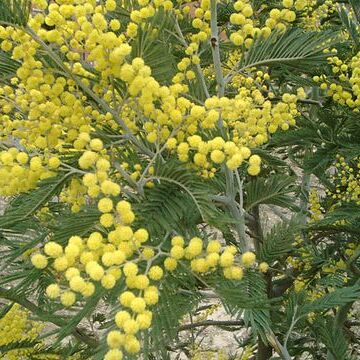Woody plants, usually armed with scattered thorns or stipular spines. Leaves (Central American species) bipinnate, the pinnae few or many, opposite, the leaf-lets mostly small and numerous; petiole in the majority of species bearing some sort of a gland or glandular field; rachis short or elongate, glandular or less often eglandular; stipules usually small and caducous but sometimes modified as promi-nent spines, in the "bull-horn" species these very large and myrmecophilous. In-florescence basically of axillary, solitary or fasciculate, pedunculate heads, spikes, umbels or racemes, often appearing paniculate because of suppression of leaves at terminal and subterminal, floriferous nodes. Flowers small, usually numerous and dense, predominately whitish or yellowish, normally exceeding the bractlets; calyx usually campanulate, sympetalous, 4-or 5-toothed; corolla typically funnelform, sympetalous for most of its length or in some species 4-to 5-cleft nearly to the base; stamens diagnostic, numerous, free or rarely somewhat united at the extreme base; anthers small, rarely glandular; ovary small, the style and terminal stigma scarcely visible among the stamens. Legume usually oblong to linear, terete or more frequently compressed or flattened, usually straight, dehiscent and with slightly elevated margins, the seeds transverse.
Shrubs or trees, often woody. Stipules normally present (but commonly caducous) and scarious, rarely spinose (e.g. spinescent stipules in A. paradoxa, A. victoriae). Leaves bipinnate or modified to polymorphic phyllodes, sometimes partly concurrent with branchlets, rarely reduced to scales or absent; foliar glands normally present. Inflorescences pedunculate or sessile, simple or racemose, infrequently paniculate; bracteoles normally present; flowers white to golden, rarely mauve-pink (A. purpureopetala) or red (A. leprosa 'Scarlet Blaze'), 2 or more aggregated into globular heads or obloid to cylindrical spikes, (3–) 4 or 5 (–6)-merous; sepals free to united, rarely absent; stamens numerous, normally free, rarely united basally into a short tube or irregularly faciculate; ovary single (rarely to 5), sessile or rarely stipitate. Legumes dehiscent or rarely indehiscent. Seeds normally with a pleurogram and without endosperm; funicle arillate or exarillate.
Armed or unarmed trees, shrubs or lianas. Stipules spinescent or not. Leaves bipinnate or modified to phyllodes by dilatation of the petiole and the proximal part of the rachis; extrafloral nectaries usually present on petiole and rachis; leaflets opposite (in Malesia), sessile to shortly stalked. Inflorescences consisting of pedunculate glomerules or spikes b >rne in axillary clusters or aggregated into terminal panicles. Flowers bisexual, or male and bisexual, tetra-or pentamerous, uniform. Calyx connate, valvate. Corolla connate, valvate. Stamens numerous (15 or more), free; anthers glandular or not. Pods extremely variable, dehiscent or indehiscent; endocarp not separating from the exocarp, not forming envelopes around each seed. Seeds usually elliptic to oblong, ± flattened, with a hard black-brown testa with pleurogram, wingless; aril usually absent, but present in some phyllodinous species.
Leaves 2-pinnate or (in introduced species) often modified to phyllodes (entire leaflike often flattened organs without pinnae or leaflets); pinnae each with one to many pairs of leaflets; gland on the upper side of the petiole usually present; glands also often present at the insertion of the pinnae.
Stamens many, fertile, their filaments free or (in A. albida and A. eriocarpa) connate into a tube at their extreme base only; anthers (at least some) glandular at the apex, or all eglandular (in all native species glandular except in A. albida, in introduced species mostly eglandular).
Flowers in spikes, spiciform racemes or round heads, hermaphrodite or male and hermaphrodite; if in heads then central flowers not enlarged and modified; inflorescences usually axillary, racemose or paniculate.
Pods very variable, dehiscent or sometimes indehiscent, flat, ± compressed, or sometimes cylindric, straight, curved, spiral or contorted, continuous or moniliform.
Trees or shrubs, sometimes climbing; the native species in our area almost invariably armed with prickles or spines, the introduced ones usually unarmed.
Phyllodes flat with one longitudinal vein, occasionally with a second longitudinal vein developed
Morphological characters and geographic distribution are the same as those of the tribe.
Calyx (in our species) gamosepalous, subtruncate or usually with 4-5 teeth or lobes.
Seeds unwinged, often with a hard smooth testa, without endosperm.
Leaf-rachis with extrafloral nectaries. Flowers sessile
Ovary stipitate to sessile, glabrous to puberulous.
Corolla 4-5(7)-lobed.

